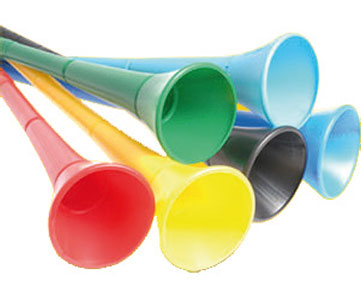Soccer has a worldwide reputation for having the loudest spectators. In Brazil matches are accompanied by the beat of samba drums, in Switzerland it’s the ringing of cow bells, in Britain it’s raucous singing and in South Africa, well it’s noise in general.
Soccer has a worldwide reputation for having the loudest spectators. In Brazil matches are accompanied by the beat of samba drums, in Switzerland it’s the ringing of cow bells, in Britain it’s raucous singing and in South Africa, well it’s noise in general.
This noise even transcends to everyday life. The blasting of vuvuzelas for example alerts Grahamstown residents to yet another strike long before there’s a picket in sight.
A vuvuzela, which needs no description or introduction, is also known as a blowing horn and is said to be rooted in South African culture although there is some dispute over this.
In 2001 South Africa’s Masincedane Sport began to mass-produce what was a tin horn into the gaudy plastic version we know so well today.
There have been many appeals for the banning of these racket-makers in stadiums as some players and (the more reserved) spectators have found them a distasteful distraction.
The defence? Vuvuzelas are a part of South African culture. It’s obvious that the lovers outnumber the haters of these flatulent cylinders, as sales are fast increasing as the World Cup gets closer.
The official Vuvuzela Company has received large orders, some for more than a million horns. On a smaller scale, Pick n Pay is marketing a 120 decibel pillbox-shaped horn as “the first mini vuvuzela” a handbag friendly alternative.
The kuduzela, an only slightly less popular horn, has recently been mass-produced also in the multi-coloured, plastic form and bought by FNB as a promotional gift.
This twirled tweeter was modeled on the traditional kudu horn used to call people together for gatherings, imbizos and, more relevantly, battle.
According to David Mabunda, chief executive of SANparks, the kuduzela will call South Africans and international guests to the “symbolic battlefield of soccer”.
As an official sponsor, FNB has purchased 150 000 and is giving SANparks R600 000 of that (6% per kuduzela) for their Kids in Parks project.
The whistle is another common earsplitter and has lately reinvented itself in the shape of, you guessed it, a soccer ball.
However, many talented windbags don’t even need the actual device to whine merrily away for up to 90 minutes.
Despite its lack of necessity it is still very popular although overshadowed by its cumbersome cousins. Wind emitters aren’t the only noise devices within South Africa’s culture of sound. Drums are an important part of African tradition.
In Mike Rossiter’s Drums in Tradition he refers to Africa as the Drum Continent “because nowhere else in the world has a greater range or type of drums”.
The skill required for this moving musicmaking seems to be profuse with rhythmic pulsations vibrating along stages and streets alike.
The drum’s popularity looks set to hammer on in the sound scene indefinitely but it seems to lack the appeal that blowing on an elongated tube has for most South Africans.
Fifa President Joseph Blatter summed up the general response to reverberation devices: “Vuvuzelas, drums and singing are part of African football culture.
It’s part of their celebration and of their culture, let them blow their vuvuzelas.” It remains to be seen how our international guests will feel about 30 000 vuvuzelas worth of South African culture smacking their eardrums at the speed of sound.
How to use a vuvuzela
•Put your lips inside the mouthpiece and make a ‘raspberry’ sound (the sound you would make if blowing on a baby’s belly).
•Relax your cheeks and let them flare out as your lips vibrate inside the mouthpiece.
•As soon as you get that blasting sound, blow harder until you reach the trumpeting crescendo.
The sound it makes
Up close a vuvuzela sounds like a trumpeting elephant but from afar many vuvuzelas blowing together sound like a swarm of angry bees. If done incorrectly the sound emitted can only be likened to that of a small, wet fart. There are rumours that the horn can be musical.
How to use a kuduzela
How to use a World Cup whistle
How to use a drum


